An Innovative Approach to Novel Lithium-ion Battery Materials
Researchers at Boise State University developed a new approach to creating novel lithium-ion battery materials. Starting from an amorphous niobium oxide, they discovered that the act of cycling the material with lithium induces a transformation to a novel crystalline Nb2O5 anode with exceptional Li storage and fast cycling. Scientists can use the process to make other lithium-ion battery materials not easily made via traditional means. The team published their study in Nature Materials.
To create the new anode material, the group developed an innovative technique called electrochemically-induced amorphous-to-crystalline transformation. The new electrode can achieve high lithium storage of 269 mAh/g at a charging rate of 20 mA/g and, more importantly, continues to retain a high capacity of 191 mAh/g at a high charging rate of 1 A/g.
The exceptional rate performance of the anode is due to its disordered rocksalt or DRX structure. Computations show that the DRX structure contains paths for fast lithium diffusion, resulting in high-rate performance.

